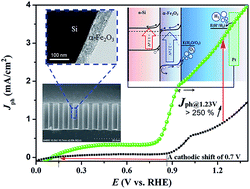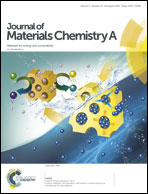Modulating oxygen vacancies in Sn-doped hematite film grown on silicon microwires for photoelectrochemical water oxidation†
Abstract
Dual-absorber photoelectrodes are attractive candidates for solar water splitting due to their broadened absorption spectrum and improved photovoltage compared to single-absorber systems. Here, we present a hybrid photoanode constructed by growing hematite (α-Fe2O3) film on silicon microwires (SiMWs); the film is demonstrated to be promising for photoelectrochemical (PEC) water splitting. We simultaneously introduce extrinsic (i.e., Sn) and intrinsic (i.e., oxygen vacancy) dopants, which lead to an increase of the photocurrent from 0.89 to 3.12 mA cm−2 at 1.23 VRHE (under AM 1.5G irradiation) and a cathodical shift of 0.7 V in the starting potential of the anode current along with a relatively high photocurrent at a low potential (e.g., 0.33 mA cm−2 at 0.45 VRHE). Moreover, the relative concentration of the oxygen vacancies in α-Fe2O3 can be modulated, and the corresponding influence on the PEC performance is investigated in detail.



 Please wait while we load your content...
Please wait while we load your content...